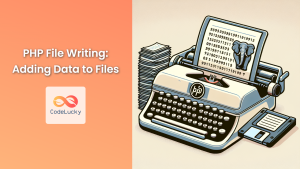In today's data-driven world, XML (eXtensible Markup Language) remains a crucial format for storing and exchanging structured information. PHP, being a versatile language, offers powerful tools for working with XML. One such tool is the XMLWriter class, which provides an efficient way to generate XML documents programmatically. In this comprehensive guide, we'll explore the XMLWriter class in PHP, diving deep into its methods and demonstrating how to create well-formed XML documents with ease.
Introduction to XMLWriter
XMLWriter is a PHP extension that allows you to create XML documents using a streaming approach. This means you can generate large XML files without loading the entire document into memory, making it an excellent choice for handling substantial amounts of data.
Let's start by creating a simple XML document to understand the basics of XMLWriter.
<?php
$writer = new XMLWriter();
$writer->openMemory();
$writer->setIndent(true);
$writer->setIndentString(' ');
$writer->startDocument('1.0', 'UTF-8');
$writer->startElement('root');
$writer->writeElement('child', 'Hello, XML!');
$writer->endElement();
$writer->endDocument();
echo $writer->outputMemory();
?>
This script produces the following XML output:
<?xml version="1.0" encoding="UTF-8"?>
<root>
<child>Hello, XML!</child>
</root>
Let's break down what's happening in this code:
- We create a new XMLWriter object.
- We use
openMemory()to start writing to memory instead of a file. - We set indentation for better readability.
- We start the XML document, specifying the version and encoding.
- We create a root element and a child element.
- We end the document and output the result.
Creating Complex XML Structures
Now that we've covered the basics, let's create a more complex XML structure. We'll build an XML document representing a bookstore inventory.
<?php
$writer = new XMLWriter();
$writer->openMemory();
$writer->setIndent(true);
$writer->setIndentString(' ');
$writer->startDocument('1.0', 'UTF-8');
$writer->startElement('bookstore');
// Book 1
$writer->startElement('book');
$writer->writeAttribute('category', 'fiction');
$writer->writeElement('title', 'The Great Gatsby');
$writer->writeElement('author', 'F. Scott Fitzgerald');
$writer->writeElement('year', '1925');
$writer->writeElement('price', '15.99');
$writer->endElement(); // book
// Book 2
$writer->startElement('book');
$writer->writeAttribute('category', 'non-fiction');
$writer->writeElement('title', 'A Brief History of Time');
$writer->writeElement('author', 'Stephen Hawking');
$writer->writeElement('year', '1988');
$writer->writeElement('price', '18.99');
$writer->endElement(); // book
$writer->endElement(); // bookstore
$writer->endDocument();
echo $writer->outputMemory();
?>
This script generates the following XML:
<?xml version="1.0" encoding="UTF-8"?>
<bookstore>
<book category="fiction">
<title>The Great Gatsby</title>
<author>F. Scott Fitzgerald</author>
<year>1925</year>
<price>15.99</price>
</book>
<book category="non-fiction">
<title>A Brief History of Time</title>
<author>Stephen Hawking</author>
<year>1988</year>
<price>18.99</price>
</book>
</bookstore>
In this example, we've introduced several new concepts:
startElement()andendElement()to create nested structureswriteAttribute()to add attributes to elements- Multiple
writeElement()calls to create sibling elements
Working with Data from Arrays
In real-world scenarios, you'll often need to generate XML from existing data structures. Let's modify our previous example to use an array of book data:
<?php
$books = [
[
'category' => 'fiction',
'title' => 'The Great Gatsby',
'author' => 'F. Scott Fitzgerald',
'year' => '1925',
'price' => '15.99'
],
[
'category' => 'non-fiction',
'title' => 'A Brief History of Time',
'author' => 'Stephen Hawking',
'year' => '1988',
'price' => '18.99'
],
[
'category' => 'fiction',
'title' => '1984',
'author' => 'George Orwell',
'year' => '1949',
'price' => '12.99'
]
];
$writer = new XMLWriter();
$writer->openMemory();
$writer->setIndent(true);
$writer->setIndentString(' ');
$writer->startDocument('1.0', 'UTF-8');
$writer->startElement('bookstore');
foreach ($books as $book) {
$writer->startElement('book');
$writer->writeAttribute('category', $book['category']);
$writer->writeElement('title', $book['title']);
$writer->writeElement('author', $book['author']);
$writer->writeElement('year', $book['year']);
$writer->writeElement('price', $book['price']);
$writer->endElement(); // book
}
$writer->endElement(); // bookstore
$writer->endDocument();
echo $writer->outputMemory();
?>
This script produces:
<?xml version="1.0" encoding="UTF-8"?>
<bookstore>
<book category="fiction">
<title>The Great Gatsby</title>
<author>F. Scott Fitzgerald</author>
<year>1925</year>
<price>15.99</price>
</book>
<book category="non-fiction">
<title>A Brief History of Time</title>
<author>Stephen Hawking</author>
<year>1988</year>
<price>18.99</price>
</book>
<book category="fiction">
<title>1984</title>
<author>George Orwell</author>
<year>1949</year>
<price>12.99</price>
</book>
</bookstore>
This approach allows you to easily generate XML from any data structure, making it highly flexible for various use cases.
Adding CDATA Sections
Sometimes, you need to include content that contains characters that could be interpreted as markup. In such cases, you can use CDATA sections. Let's modify our book example to include a description that might contain HTML:
<?php
$books = [
[
'category' => 'fiction',
'title' => 'The Great Gatsby',
'author' => 'F. Scott Fitzgerald',
'year' => '1925',
'price' => '15.99',
'description' => 'A story of <em>decadence</em> and <strong>excess</strong> in the Jazz Age.'
],
[
'category' => 'non-fiction',
'title' => 'A Brief History of Time',
'author' => 'Stephen Hawking',
'year' => '1988',
'price' => '18.99',
'description' => 'An overview of <em>space</em>, <strong>time</strong>, and the <u>universe</u>.'
]
];
$writer = new XMLWriter();
$writer->openMemory();
$writer->setIndent(true);
$writer->setIndentString(' ');
$writer->startDocument('1.0', 'UTF-8');
$writer->startElement('bookstore');
foreach ($books as $book) {
$writer->startElement('book');
$writer->writeAttribute('category', $book['category']);
$writer->writeElement('title', $book['title']);
$writer->writeElement('author', $book['author']);
$writer->writeElement('year', $book['year']);
$writer->writeElement('price', $book['price']);
$writer->startElement('description');
$writer->writeCdata($book['description']);
$writer->endElement(); // description
$writer->endElement(); // book
}
$writer->endElement(); // bookstore
$writer->endDocument();
echo $writer->outputMemory();
?>
This script generates:
<?xml version="1.0" encoding="UTF-8"?>
<bookstore>
<book category="fiction">
<title>The Great Gatsby</title>
<author>F. Scott Fitzgerald</author>
<year>1925</year>
<price>15.99</price>
<description><![CDATA[A story of <em>decadence</em> and <strong>excess</strong> in the Jazz Age.]]></description>
</book>
<book category="non-fiction">
<title>A Brief History of Time</title>
<author>Stephen Hawking</author>
<year>1988</year>
<price>18.99</price>
<description><![CDATA[An overview of <em>space</em>, <strong>time</strong>, and the <u>universe</u>.]]></description>
</book>
</bookstore>
By using writeCdata(), we ensure that the HTML in our descriptions is treated as plain text and not parsed as XML.
Writing to a File
So far, we've been outputting our XML to memory. In many cases, you'll want to write directly to a file. Let's modify our script to save the XML to a file:
<?php
$books = [
// ... (same book data as before)
];
$filename = 'bookstore.xml';
$writer = new XMLWriter();
$writer->openUri($filename);
$writer->setIndent(true);
$writer->setIndentString(' ');
$writer->startDocument('1.0', 'UTF-8');
$writer->startElement('bookstore');
foreach ($books as $book) {
$writer->startElement('book');
$writer->writeAttribute('category', $book['category']);
$writer->writeElement('title', $book['title']);
$writer->writeElement('author', $book['author']);
$writer->writeElement('year', $book['year']);
$writer->writeElement('price', $book['price']);
$writer->startElement('description');
$writer->writeCdata($book['description']);
$writer->endElement(); // description
$writer->endElement(); // book
}
$writer->endElement(); // bookstore
$writer->endDocument();
$writer->flush();
echo "XML file '$filename' has been created successfully.";
?>
This script creates a file named bookstore.xml in the same directory as the PHP script. The openUri() method is used instead of openMemory() to write directly to a file, and flush() is called at the end to ensure all data is written to the file.
Adding Comments and Processing Instructions
XMLWriter also allows you to add comments and processing instructions to your XML documents. Let's enhance our bookstore XML with these features:
<?php
$books = [
// ... (same book data as before)
];
$writer = new XMLWriter();
$writer->openMemory();
$writer->setIndent(true);
$writer->setIndentString(' ');
$writer->startDocument('1.0', 'UTF-8');
// Add a processing instruction
$writer->writePI('xml-stylesheet', 'type="text/xsl" href="bookstore.xsl"');
$writer->startElement('bookstore');
// Add a comment
$writer->writeComment('This is our bookstore inventory');
foreach ($books as $book) {
$writer->startElement('book');
$writer->writeAttribute('category', $book['category']);
$writer->writeElement('title', $book['title']);
$writer->writeElement('author', $book['author']);
$writer->writeElement('year', $book['year']);
$writer->writeElement('price', $book['price']);
$writer->startElement('description');
$writer->writeCdata($book['description']);
$writer->endElement(); // description
$writer->endElement(); // book
}
$writer->endElement(); // bookstore
$writer->endDocument();
echo $writer->outputMemory();
?>
This script produces:
<?xml version="1.0" encoding="UTF-8"?>
<?xml-stylesheet type="text/xsl" href="bookstore.xsl"?>
<bookstore>
<!--This is our bookstore inventory-->
<book category="fiction">
<title>The Great Gatsby</title>
<author>F. Scott Fitzgerald</author>
<year>1925</year>
<price>15.99</price>
<description><![CDATA[A story of <em>decadence</em> and <strong>excess</strong> in the Jazz Age.]]></description>
</book>
<book category="non-fiction">
<title>A Brief History of Time</title>
<author>Stephen Hawking</author>
<year>1988</year>
<price>18.99</price>
<description><![CDATA[An overview of <em>space</em>, <strong>time</strong>, and the <u>universe</u>.]]></description>
</book>
</bookstore>
Here, we've added:
- A processing instruction (
<?xml-stylesheet ... ?>) to link an XSL stylesheet. - A comment (
<!--This is our bookstore inventory-->) to provide additional information.
Conclusion
The XMLWriter class in PHP provides a powerful and flexible way to generate XML documents. From simple structures to complex, nested elements with attributes, CDATA sections, comments, and processing instructions, XMLWriter can handle it all. Its streaming approach makes it efficient for creating large XML files without consuming excessive memory.
Here's a quick recap of the key XMLWriter methods we've covered:
startDocument()andendDocument()to begin and end the XML documentstartElement()andendElement()to create XML elementswriteElement()to create simple elements with contentwriteAttribute()to add attributes to elementswriteCdata()to include CDATA sectionswriteComment()to add commentswritePI()to insert processing instructions
By mastering these methods, you'll be well-equipped to generate any XML structure required for your PHP applications. Whether you're creating RSS feeds, SOAP messages, or any other XML-based data exchange format, XMLWriter provides the tools you need to get the job done efficiently and correctly.
Remember to always validate your XML output to ensure it meets the requirements of the systems consuming it. Happy XML writing with PHP! 🚀📝



















